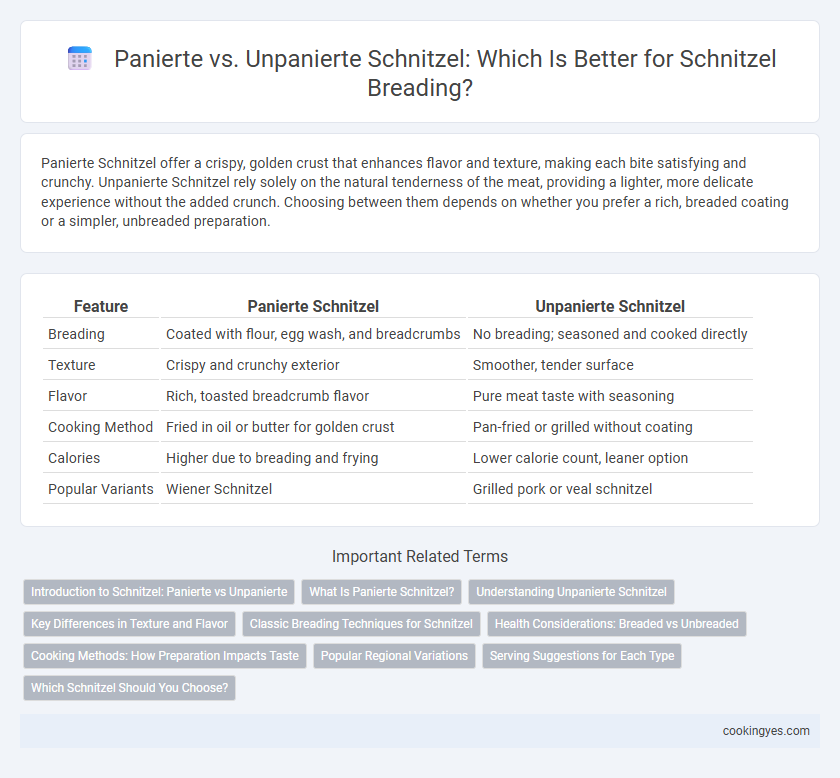Panierte Schnitzel offer a crispy, golden crust that enhances flavor and texture, making each bite satisfying and crunchy. Unpanierte Schnitzel rely solely on the natural tenderness of the meat, providing a lighter, more delicate experience without the added crunch. Choosing between them depends on whether you prefer a rich, breaded coating or a simpler, unbreaded preparation.
Table of Comparison
| Feature | Panierte Schnitzel | Unpanierte Schnitzel |
|---|---|---|
| Breading | Coated with flour, egg wash, and breadcrumbs | No breading; seasoned and cooked directly |
| Texture | Crispy and crunchy exterior | Smoother, tender surface |
| Flavor | Rich, toasted breadcrumb flavor | Pure meat taste with seasoning |
| Cooking Method | Fried in oil or butter for golden crust | Pan-fried or grilled without coating |
| Calories | Higher due to breading and frying | Lower calorie count, leaner option |
| Popular Variants | Wiener Schnitzel | Grilled pork or veal schnitzel |
Introduction to Schnitzel: Panierte vs Unpanierte
Panierte Schnitzel features a crispy breadcrumb coating that enhances flavor and texture, commonly made with pork or veal, while unpanierte Schnitzel is simply seasoned and lightly fried without breading, offering a tender, natural meat experience. The breadcrumb crust in panierte versions provides a satisfying crunch and golden-brown appearance, essential for dishes like Wiener Schnitzel. In contrast, unpanierte Schnitzel highlights the pure meat quality and is often preferred for its simplicity and lighter calorie content.
What Is Panierte Schnitzel?
Panierte Schnitzel refers to a breaded schnitzel that is coated in a three-step process involving flour, beaten eggs, and breadcrumbs, which creates a crispy and flavorful outer layer when fried. This method enhances texture and adds a delightful crunch compared to unpanierte schnitzel, which is simply seasoned and fried without breading. The use of breadcrumbs in panierte schnitzel contributes to moisture retention and an appealing golden-brown finish.
Understanding Unpanierte Schnitzel
Unpanierte Schnitzel, unlike panierte schnitzel, are prepared without the traditional breadcrumb coating, emphasizing the natural texture and flavor of the meat. This style allows the schnitzel to retain a juicier interior and a simpler, cleaner taste profile, often relying on a light seasoning blend. Chefs value unpanierte schnitzel for its quick cooking time and ability to showcase high-quality meat without the added calories from breading.
Key Differences in Texture and Flavor
Panierte Schnitzel feature a crispy, golden breadcrumb coating that adds a crunchy texture and rich, savory flavor, enhancing the overall eating experience. Unpanierte Schnitzel lack this breaded exterior, resulting in a tender, juicy texture with a pure meat flavor that is less complex but more natural. The breaded version's texture contrasts significantly with the smooth mouthfeel of unpanierte Schnitzel, making the choice dependent on preference for crispiness versus simplicity.
Classic Breading Techniques for Schnitzel
Classic breading techniques for Schnitzel involve dipping the meat sequentially in flour, beaten eggs, and fine breadcrumbs to achieve a crispy, golden crust. Panierte Schnitzel refers to this traditional breaded preparation, which enhances texture and flavor through the breadcrumb coating. In contrast, unpanierte Schnitzel skips the breading step, resulting in a more tender and less crunchy surface that highlights the natural taste of the meat.
Health Considerations: Breaded vs Unbreaded
Panierte Schnitzel typically contains more calories and fat due to the breading absorbing oil during frying, increasing its overall fat content compared to unpanierte Schnitzel. Unbreaded Schnitzel offers a leaner alternative with fewer carbohydrates and less oil absorption, making it a healthier option for those monitoring calorie intake or fat consumption. Choosing unbreaded Schnitzel can reduce exposure to processed breadcrumbs and lower the risk of inflammation linked to fried, breaded foods.
Cooking Methods: How Preparation Impacts Taste
Panierte Schnitzel, coated in breadcrumbs, develop a crispy, golden crust through frying, enhancing texture and flavor complexity due to Maillard reactions. Unpanierte Schnitzel, prepared without breading, rely on direct searing, which preserves the meat's natural juiciness and tender interior but offers less crunch. The choice of breading significantly impacts moisture retention and the balance between crispy exterior and succulent meat, shaping the overall taste experience.
Popular Regional Variations
Panierte Schnitzel, breaded with a mixture of flour, egg, and breadcrumbs, is most popular in Germany and Austria, where Wiener Schnitzel exemplifies this crispy preparation. Unpanierte Schnitzel, often found in regions of Bavaria and parts of Italy, features a simple, non-breaded cutlet seasoned and pan-fried, highlighting the meat's natural flavor. These regional preferences reflect local culinary traditions and ingredient availability, with panierte versions emphasizing crunch and texture, while unpanierte varieties prioritize tenderness and pure taste.
Serving Suggestions for Each Type
Panierte Schnitzel pairs perfectly with classic sides like potato salad, spaetzle, or a fresh cucumber salad, enhancing its crispy breaded texture. Unpanierte Schnitzel, served without breading, complements lighter accompaniments such as steamed vegetables, lemon wedges, or creamy mushroom sauce to highlight the tender meat's natural flavor. Both types can be enjoyed with mustard or lingonberry jam for an authentic Bavarian experience.
Which Schnitzel Should You Choose?
Panierte Schnitzel offers a crispy, golden-brown crust achieved by coating the meat in flour, egg, and breadcrumbs, enhancing texture and flavor. Unpanierte Schnitzel, without breading, highlights the pure taste and tenderness of the meat, ideal for those seeking a lighter option. Choose panierte for crunch and richness or unpanierte for simplicity and a more natural meat profile.
Panierte Schnitzel vs Unpanierte Schnitzel for breading Infographic

 cookingyes.com
cookingyes.com